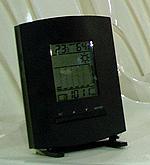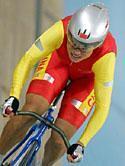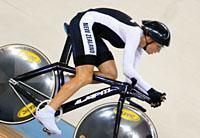
Recently on Cyclingnews.com |
The current time in Athens is 02:57 on July 5, 2025 - For current weather, click here
28th Olympic Games - JO
Athens, Greece, August 14-28, 2004
Sunday, August 22, 2004
Humidity, heat and speed
Why track records are falling at Athens

|
"I wasn't looking at a world record here, but the conditions were hot and dry, and that's when the track is always fastest," said Olympic champion Anna Meares after her Olympic and world record-breaking ride in the women's 500m time trial. As it happens Meares was half right - hot, humid weather provides the best conditions for breaking records on the track. As John Stevenson and Gerard Knapp explain, it's all a matter of aerodynamics and gas physics.
Why are track records falling at Athens, a sea-level velodrome that wasn't expected to be fast? Of course, these are the world's best cyclists in the form of their lives, with the women endurance riders, especially Sarah Ulmer and Katie Mactier, challenging each other to repeatedly break the world record.
Inside the velodrome, the boards have been shaved smooth and well dried-out after a hot Athens summer. But more importantly, it's the heat and humidity in the air. Hot air is less dense, and therefore easier to push through and increased humidity involves the air being partly replaced with less dense water vapour.
Combine these elements of great athletes and dry track with hot and humid conditions - especially as hot air can contain more water vapour than cold air - and the scene is set for records if the riders are up to the task, as they have shown repeatedly in Athens. Away from competition, the ambient temperature and humidity are of such importance that readings are taken during timed solo qualification rides; if it's too cool and dry, then the times have to be adjusted accordingly (using a formula for each timed event on the track).
Earlier this year, Australian rider Brad McGee posted a qualifying time of 'only' 4.24.69 in a 4km pursuit (against the clock only) to make his way on to the shadow Australian Olympic team. But this was set on an unseasonally cool night in Sydney's Dunc Gray Velodrome during January, the southern hemisphere summer.

|
At the time, McGee said the conditions "made it very, very difficult. It was so cold, it was heavy, it was like trying to ride through a swimming pool." McGee made his attempt when the temperature was only 23 degrees celsius (unlike Athens, where it's above 36 degrees inside the velodrome) but the humidity was at 64%.
While our perception may be that riding in high heat and humidity is harder, due to the increased perspiration, timed events on the track are relatively short, so hydration is not an issue. Also, water vapour is made up of hydrogen atoms, and hydrogen is 'lighter' than nitrogen (see detailed explanation below). The biggest impediment to fast times is wind resistance - or in the case of a velodrome - air resistance. And it's the composition and temperature of the ambient air that defines the times.
It could be argued the biggest advances in velodrome times are due to aerodynamic enhancements, such as profile 'bars and most importantly, disc wheels. An experienced coach once told Cyclingnews that above 40km/h, if a rider is not on at least one disc wheel, they're out of contention, they make such a difference.
Then there is the rider's position. Go back to Meares' WR ride in the 500m TT on Friday evening in Athens. The penultimate rider before the Australian (who was last to ride) was China's Yonghua Jiang, who flew out of the gate and put in the fastest first 250m-lap of all contenders and finished the second in 34.112 seconds. But Jiang was using 'bullhorn' handlebars.

|
Meares then came on to the track with her tiny, rigid BT sprinter's bike, but set up with the low-profile tri-bars, like a pursuiter. Essentially, Meares won the gold in her first lap. After she clocked her first lap some 28/1000s of a second faster than Jiang, the medal was her's, as by that time she was tucked into an aerodynamically superior position to the Chinese rider and used her power and skill to hug the optimum racing line to drive it home. Cyclingnews has observed her coach Martin Barras, begin to smile after her first lap of her 500m TT, as if he knows his rider has already won. She did it in Melbourne, and she did it again in Athens.
A more detailed explanation
By John Stevenson
In cycling, the rider's biggest enemy - after his or her competitors - is the air. In pure against-the-clock events such as the kilo, 500m and pursuit, the factor that can make a difference between breaking a world or Olympic record and not is the resistance from the mixture of gases that riders have to punch their way through on their frantic dash to the finish line.
Assuming it's not windy - the case for indoor velodromes and conditions at the Athens track events so far have been less affected by wind in the partially-open velodrome than was feared - the air property that matters most is its density. Fluids such as air and water are harder to move through the more dense they are, which is why it's a lot harder to ride a bike through a river than along a road.
The difference between the density of the air at one time and another is less extreme, but it's still significant when you're measuring a cyclist to a thousandth of a second over four kilometers.
Three things affect air density: altitude, temperature and humidity. To understand what's going on here, it's convenient to imagine the molecules and atoms that make up the air as being 'point masses' - that is, specks of matter with mass but no volume. The heat energy of the gas molecules causes them to whiz about all over the place like a Greek sprinter evading a drug test, and in the process the bulk gas expands to fill whatever container it's in - or until it's constrained by some other factor like the Earth's gravity.
Gravity keeps the atmosphere in place and weight of the atmosphere compresses the air at sea level to the density we're all familiar with. As you go higher there's less air above you to compress the air around you, its density is lower and you go faster for a given effort. This is why track records have traditionally been set at altitude. Arnoud Tournant's 58.87 second record for the kilometer was set at the La Paz velodrome in Bolivia at an altitude of 3,417m, for example.
Temperature has a similar effect. By increasing the speed at which the air molecules move, a higher temperature causes the bulk gas to occupy more volume, if it can. The Athens velodrome isn't airtight (a good job too, as all the spectators who turned out to have been patiently waiting for the track racing to start before showing their faces last night would have suffocated if it were) so higher temperatures mean less dense air, and faster times.
The effect of humidity is perhaps the least obvious. Humidity is a measure of the amount of water vapour the air contains - in other words, it's an indication of the composition of the air. Perfectly dry air consists mostly of oxygen and nitrogen, with a bit of an inert gas called argon and a trace of carbon dioxide. For our purposes we can ignore everything but the nitrogen and oxygen, which make up 78 percent and 21 percent of the air, respectively. As the humidity increases a small but significant amount of water vapour is added to the mix.

|
The air's density is affected by its volume, as we've seen with the effect of altitude and temperature, but also by its average mass. Because air behaves as a bunch of point masses whizzing about, any given number of gas molecules will occupy the same volume at a given temperature and pressure.
The mass of a molecule of gas is determined by the masses of the atoms that come together to form it. A water molecule is made up of two atoms of hydrogen and one of oxygen - the good old chemical formula H2O. Hydrogen atoms are the lightest atoms around, so their 'atomic weight' is considered to be 1 and the weight of all other atoms is expressed proportional to a hydrogen atom. (Actually the baseline is 1/12 of the weight of a carbon-12 atom, but for our purposes it's the same thing). An oxygen atom has an atomic weight of 16 and a nitrogen atom a weight of 14.
There are two atoms in the oxygen and nitrogen molecules in the air, so their molecular masses are 32 and 28 respectively. The molecular weight of water, however, is just 18: 1 + 1 + 16. That means that as you increase the humidity, water molecules displace some of the oxygen and nitrogen molecules. The volume stays the same, so the density of the air goes down and, once again, times decrease.
